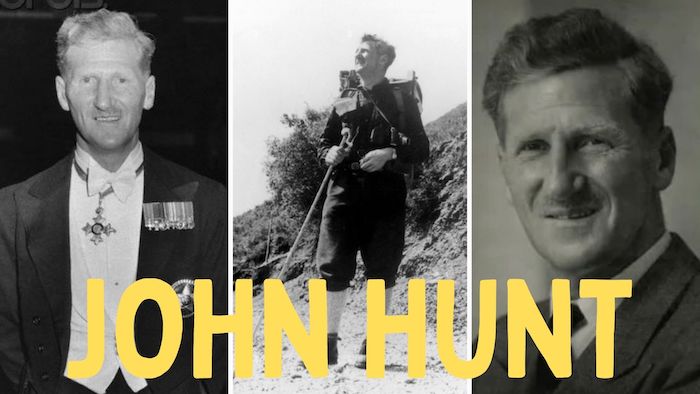Sir John Hunt, a distinguished British army officer and seasoned mountaineer, etched his name into the annals of history as the leader of the 1953 British Everest Expedition. Born on June 22, 1910, in Simla India, Hunt’s guidance helped the expedition achieve the seemingly impossible feat of conquering the highest peak on Earth, Mount Everest.
John Hunt’s legacy as a pioneering adventurer and leader continues to inspire generations of mountaineers and adventurers worldwide. This blog recounts John Hunt’s life and involvement on Mount Everest.
Early Life and Military Career of John Hunt:
Hunt was born on June 22, 1910, in Simla, British India. His father, Captain Cecil Edwin Hunt of the Indian Army, tragically lost his life during the First World War. Growing up, Hunt spent many of his holidays in the Alps, where he developed mountaineering skills that would serve him well in his future Himalayan expeditions while stationed in India. Remarkably, at the age of 14, he completed a guided ascent of Piz Palu.
After receiving his education at Marlborough College, Hunt went on to attend the Royal Military College, Sandhurst, where he distinguished himself by receiving the King’s Gold Medal and the Anson Memorial Sword.
Hunt was commissioned as a second lieutenant in the King’s Royal Rifle Corps (KRRC) on January 30, 1930. The regiment was assigned to India in 1931, where he was promoted to the rank of lieutenant in 1933. Despite his privileged background, Hunt felt somewhat out of place with the social norms of the Raj. He favored rugby over polo, and in addition to already being fluent in German and French, he also learned Urdu and some Bengali
In 1934, he became a Military Intelligence officer in the Indian Army and was seconded to the Indian Police. During this time, he even worked undercover in Chittagong, gathering intelligence while disguised in local attire. For his efforts, he was awarded the Indian Police Medal before returning to his regiment in 1935.
Hunt’s Love for Mountaineering Blossoms:
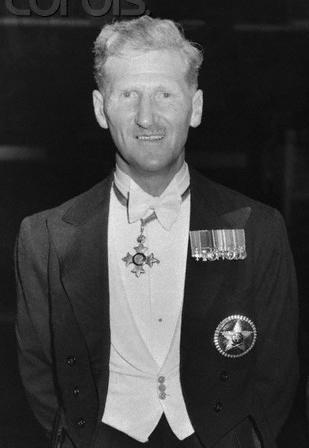
Throughout this period, Hunt continued his passion for mountaineering in the Himalayas. He attempted Saltoro Kangri in 1935, reaching an impressive altitude of 24,500 feet (7,470 m), which led to his election to the Alpine Club and the Royal Geographical Society. Despite his desire to join the 1936 Everest Expedition, he was turned down due to the discovery of a minor heart problem during an RAF medical examination.
In 1936, Hunt married Joy Mowbray-Green, who also shared his passion for exploration. Together with Reggie Cooke, they embarked on a Himalayan trip in 1937, during which they conducted reconnaissance of Kangchenjunga, scaled the south-western summit of Nepal Peak, and completed only the third ascent of the Zemu Gap, situated between Kangchenjunga and Simvo. Additionally, during this expedition, they encountered what they believed to be tracks of the elusive Yeti. In 1938, Hunt returned for another period of secondment in Military Intelligence, achieving the rank of substantive captain.
John Hunt in World War II:
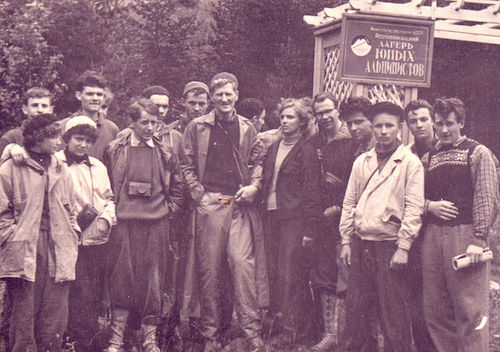
Upon his return to the United Kingdom in 1940, Hunt assumed the position of chief instructor at the Commando Mountain and Snow Warfare School in Braemar. However, he went back to regimental duty in 1943, now holding the rank of war substantive major and acting lieutenant colonel. In this capacity, he became the Commanding Officer (CO) of the 11th Battalion of the KRRC. The battalion formed the motorized infantry component of the 23rd Armoured Brigade, and under Hunt’s leadership, they played a significant role in the Italian Campaign.
Hunt’s exceptional leadership during the fierce fighting on the River Sangro in 1944 earned him an immediate award of the Distinguished Service Order (DSO). His commendation for the DSO highlighted his constant presence on the front lines, where he organized raids and ambushes to keep the enemy off balance.
Later in October 1944, his battalion was transferred to Greece, just as tensions leading to the Greek Civil War were escalating. In Greece, Hunt was temporarily promoted to brigadier and entrusted with the command of the 11th Indian Infantry Brigade, a part of the 4th Indian Infantry Division stationed in Patras. This period proved to be one of the most challenging in his military career, as he endeavored to keep the peace between various factions amidst a tense and volatile situation. His skillful handling of the complex environment earned him the Commander of the Order of the British Empire (CBE) recognition in June 1945.
Following his service in Greece, John Hunt attended the Staff College, Camberley, in 1946, and subsequently held various staff appointments in the Middle East and Europe. His rank was granted the substantive status of major in 1946, and he rose to the rank of substantive colonel in 1952.
John Hunt and the First Summit of Mount Everest:
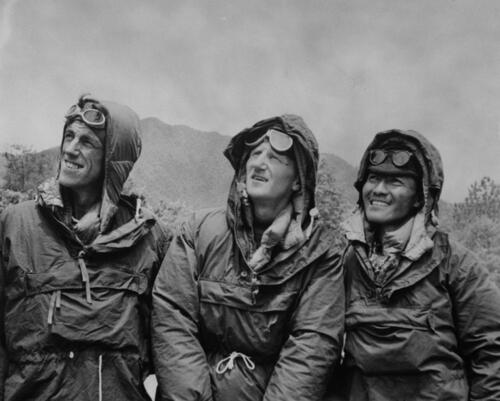
Hunt found himself working at Supreme Headquarters Allied Expeditionary Force (SHAEF) when he received an invitation to lead the 1953 British Mount Everest expedition. Initially, it was expected that Eric Shipton, who had led the previous year’s (unsuccessful) British attempt on Cho Oyu and whose team formed the majority of the climbers, would lead the expedition. However, the Joint Himalayan Committee of the Alpine Club and Royal Geographical Society, responsible for overseeing British attempts on Everest, chose Hunt for his military leadership experience and climbing credentials, believing he provided the best chance of success.
Despite many members of the expedition initially feeling loyalty to Shipton and being unhappy with his replacement, Hunt managed to win them over with his personality and candid acknowledgment of the poorly handled change. He meticulously planned three assaults with two climbers each.
They established Base Camp on April 12, 1953, and the subsequent days were dedicated to creating a route through the Khumbu Icefall. Sherpas tirelessly transported tons of supplies up the mountain, establishing a series of advanced camps higher up. By May 21, Wilfrid Noyce and Annullu reached the critical South Col, marking a significant milestone. Hunt selected two climbing pairs to make an attempt at the summit.
The first, Tom Bourdillon and Charles Evans, set out on May 26 but were compelled to turn back due to exhaustion at high altitude. On the same day, Hunt himself climbed to 8,350 meters (27,395 ft) with Da Namgyal Sherpa, leaving essential equipment on the Southeast Ridge for the second summit party.
On May 28, the expedition launched its second assault on the summit with the second climbing pair, who conquered it at 11:30 am on May 29, 1953. The two successful climbers were New Zealander Edmund Hillary and Nepalese Sherpa Tenzing Norgay.
Recognition and Awards for Hunt and the Team

The news of the expedition’s success coincidentally reached London on the morning of Queen Elizabeth II’s coronation. A few days later, back in Kathmandu, the team learned that Hillary was made a Knight Commander of the Order of the British Empire and Hunt was honored as a Knight Bachelor for their remarkable achievements.
Numerous further honors and awards were bestowed upon Hunt and the entire expedition team. These included the prestigious Hubbard Medal from the National Geographic Society (the first collective award of this medal, with individual bronze replicas made for Hunt, Hillary, and Norgay), the Founder’s Medal from the Royal Geographical Society, the Lawrence Medal from the Royal Central Asian Society, and honorary degrees from Aberdeen, Durham, and London universities.
The End of Hunt’s Life:
After returning to active duty in the Army, Hunt assumed the role of assistant commandant at Sandhurst. Following his retirement from military service in 1956, with the honorary rank of brigadier, he took on a significant responsibility as the inaugural Director of the Duke of Edinburgh Award Scheme, successfully serving in this position for a decade. In 1958, he also provided an account of the British Caucasus Expedition.
In recognition of his commendable work with young people, Hunt was bestowed with a Life Peerage in the 1966 Queen’s Birthday Honors. His title was officially designated as Baron Hunt, of Llanfair Waterdine in Shropshire.
Dedicating himself to various public roles, Hunt became the first Chairman of the Parole Board and offered valuable advisory services on policing matters in Northern Ireland. His contributions led to the Hunt Report, which recommended the dissolution of the B-Specials and the establishment of a purely military reserve force, resulting in the creation of the Ulster Defence Regiment. In 1974, he was appointed to the Royal Commission on the Press. His exemplary service was recognized in 1979 when he was invested as a Knight of the Garter.
On November 7, 1998, at the age of 88, Lord Hunt passed away in Henley-on-Thames, Oxfordshire, leaving behind four daughters.
Remembering John Hunt and his Leadership on Everest:
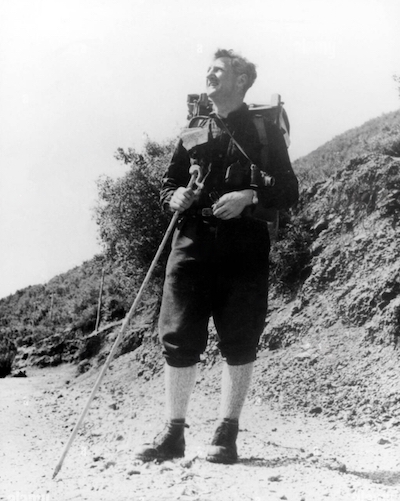
John Hunt’s life was a remarkable journey of leadership, exploration, and public service. From his early mountaineering endeavors in the Alps to his pivotal role in leading the successful 1953 British Mount Everest expedition, Hunt proved himself as an exceptional mountaineer and military strategist.
After retiring from the Army, he continued to make significant contributions to society, serving as the first Director of the Duke of Edinburgh Award Scheme and playing crucial roles in advisory work on policing in Northern Ireland and the Royal Commission on the Press.
Hunt’s legacy extends beyond his mountaineering achievements, as he dedicated much of his life to empowering young people and promoting public welfare. His contributions earned him a Life Peerage and the prestigious title of Knight of the Garter. Lord Hunt’s passing in 1998 marked the end of a life lived with purpose, leaving behind an enduring legacy that continues to inspire.
FAQs: John Hunt on Everest
Below are some of the most frequently asked questions regarding John Hunt’s life and Everest expedition.
No, John Hunt did not summit Everest. In 1952, Hunt received a special leave from the British Army of the Rhine to oversee and lead the British expedition that ultimately triumphed over Mount Everest in May 1953.
Henry Cecil John Hunt, known as Baron Hunt, KG, CBE, DSO, was a distinguished British Army officer, primarily renowned for his leadership role in the victorious 1953 British expedition to Mount Everest. This expedition marked a historic moment in mountaineering history.
John Hunt, a prominent British army officer, mountaineer, and explorer, gained widespread recognition for his exceptional leadership during the 1953 expedition, which culminated in the historic achievement of Edmund Hillary and Tenzing Norgay reaching the summit of Mount Everest.
